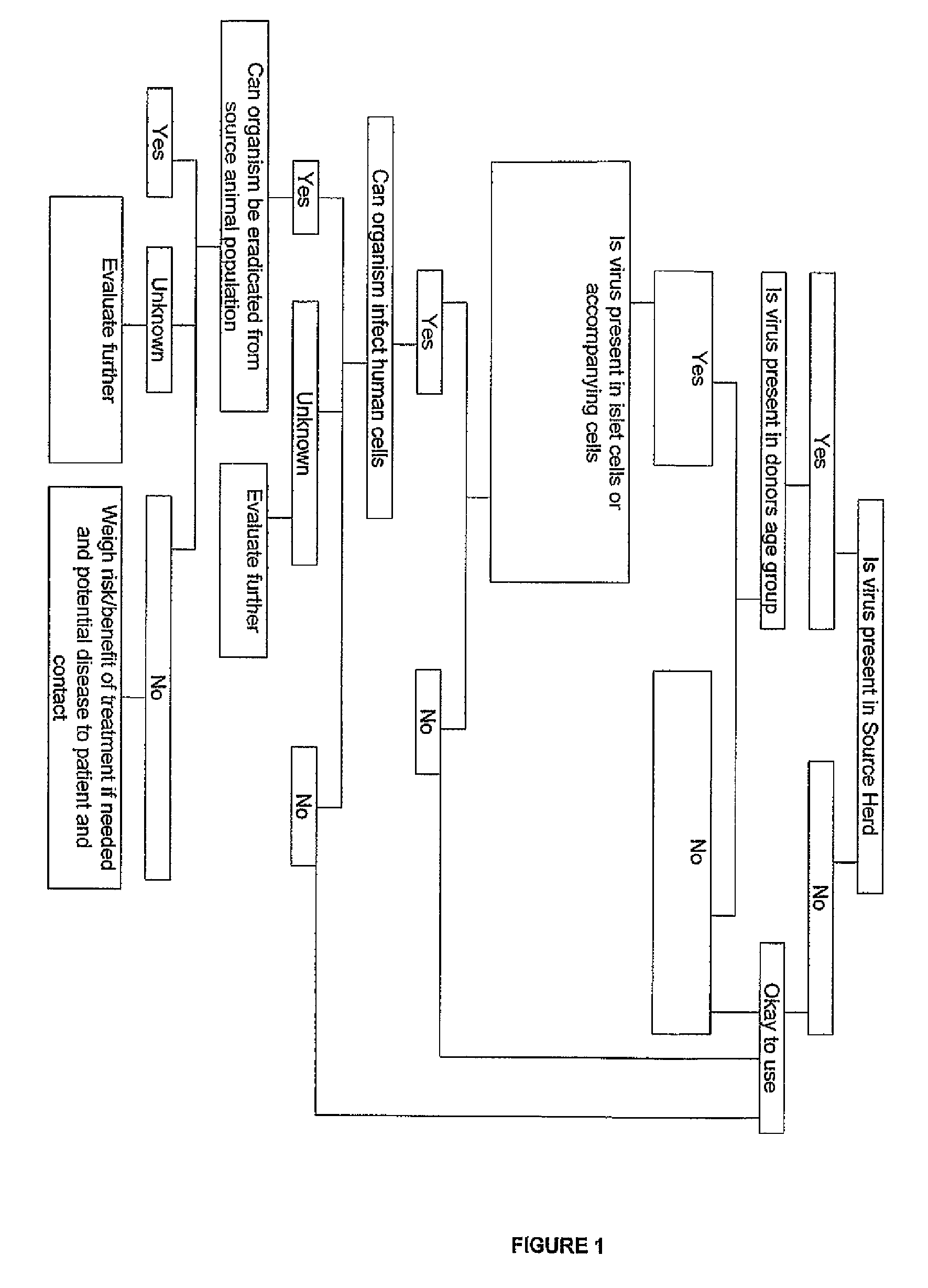Swine population having low levels of porcine endogenous retrovirus and uses thereof
a technology of endogenous retrovirus and porcine population, which is applied in the field of porcine endogenous retrovirus and low levels of porcine endogenous retrovirus and uses thereof, can solve the problems of limiting the number of organ transplant operations, shortage of donor organs, and transplantation limiting the number of operations carried out, so as to reduce the content of microorganisms and low perv copy number
- Summary
- Abstract
- Description
- Claims
- Application Information
AI Technical Summary
Benefits of technology
Problems solved by technology
Method used
Image
Examples
example i
[0126]This example details the characterization of the viral status of the low PERV copy number AI pig herd.
[0127]Materials and Methods
[0128]Nucleic Acid Extraction.
[0129]Porcine materials processed included tissue, peripheral blood mononuclear cells, plasma, and faeces.
[0130]Extraction from tissues: tissue samples (30 mg) for RNA extraction were homogenised with 1 ml of TRIZOL reagent (GIBCO / BRL, Gaitherburg, Md.) or lysis buffer from the Qiagen Rneasy Kit (Qiagen) using a glass homogeniser (Wheaton). RNA was extracted using the Qiagen Rneasy Kit (Qiagen) or TRIZOL reagent (GIBCO / BRL, Gaitherburg, Md.). DNA from tissue was extracted using Puregene DNA Isolation Kit (Gentra) in accordance with the manufacturer's recommendations.
[0131]Extraction from blood cells: DNA from peripheral blood mononuclear cells (PBMCs) was extracted with the Purogene Isolation Kit (Gentra). RNA from PBMCs was isolated with TRIZOL reagent (GIBCO / BRL, Gaitherburg, Md.).
[0132]Extraction from faeces. RNA from...
example 2
[0170]This example presents the determination of PERV copy number of exemplary members of the Auckland Island herd.
[0171]Methods
[0172]Two techniques were used to calculate PERV proviral number in the pig genome: LightCycler (Roche), and PCR limiting dilution assay (PLDA) with computational analysis using QUALITY (Rodrigo et al, ubik.microbiol.washington.edu / computing).
[0173]Results
[0174]Both techniques gave good concordance with respect to proviral insert numbers. The average copy number in the AI herd was 14 or 19 by LightCycler and PLDA, respectively.
[0175]It was also established that PERV copy number varies between individual pigs within the AI herd. PERV copy number varied from 3 to 37 (37, 16, 10, 4, 12, 16, 20, 3, 14) copies by LightCycler, and from 4 to 30 copies by PLDA. It was shown that all three classes of PERV (PERV-A, -B, -C) were present in members of the AI herd.
[0176]PERV is present in the genome of every breed of swine. Most commonly, approximately 50 copies of the ...
example 3
[0178]This example presents an analysis of the blood group of exemplary members of the Auckland Island herd.
[0179]Methods
[0180]Two techniques were used to determine the blood group of the swine. The first method utilized monoclonal antibodies to detect blood group antigens present in buccal tissue samples taken from exemplary members. Mouse anti-A and anti-B monoclonal antibodies from Diagnostic Scotland ALBA-clone were used as primary antibodies. These primary antibodies were detected with the fluorescently-labelled anti-mouse IgFITC as secondary antibody.
[0181]The second method detected the presence in serum samples of antibodies that were reactive against synthetic blood group antigens present on fetal pig cells. Fetal pig cells with surface blood group A synthetic molecules (Ap) or synthetic B molecules (Bp) or nothing (Op) were tested against the serum from 65 AI pigs in an agglutination assay. Those pig serums that did not react with group Ap cell were deemed to be group A, th...
PUM
| Property | Measurement | Unit |
|---|---|---|
| risk of transmission | aaaaa | aaaaa |
| width | aaaaa | aaaaa |
| nucleic acid detection assays | aaaaa | aaaaa |
Abstract
Description
Claims
Application Information
 Login to View More
Login to View More - R&D
- Intellectual Property
- Life Sciences
- Materials
- Tech Scout
- Unparalleled Data Quality
- Higher Quality Content
- 60% Fewer Hallucinations
Browse by: Latest US Patents, China's latest patents, Technical Efficacy Thesaurus, Application Domain, Technology Topic, Popular Technical Reports.
© 2025 PatSnap. All rights reserved.Legal|Privacy policy|Modern Slavery Act Transparency Statement|Sitemap|About US| Contact US: help@patsnap.com

